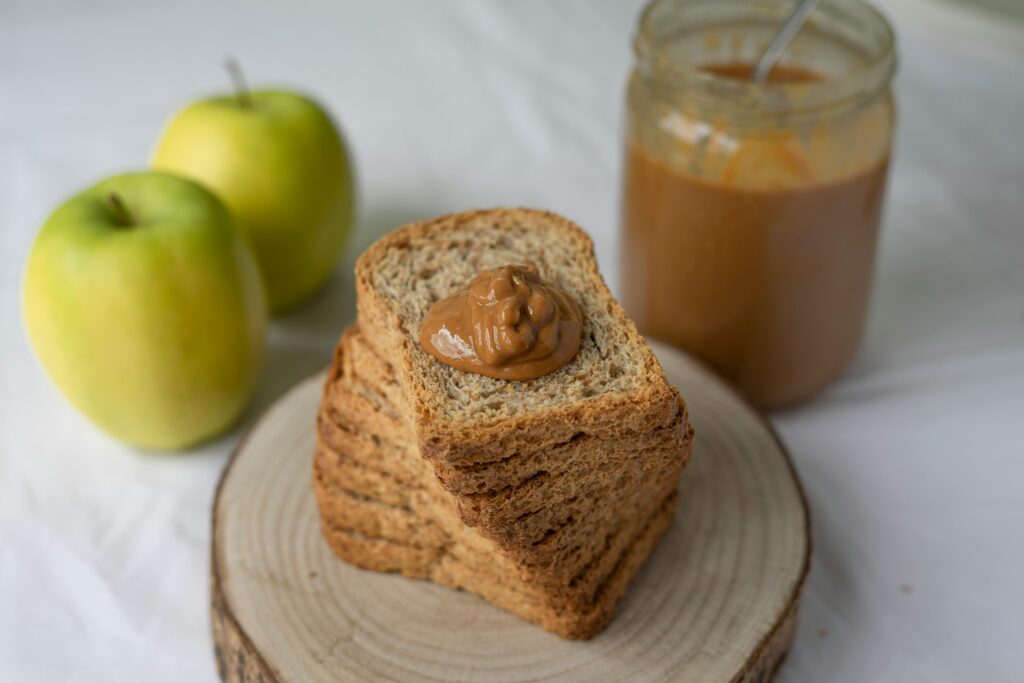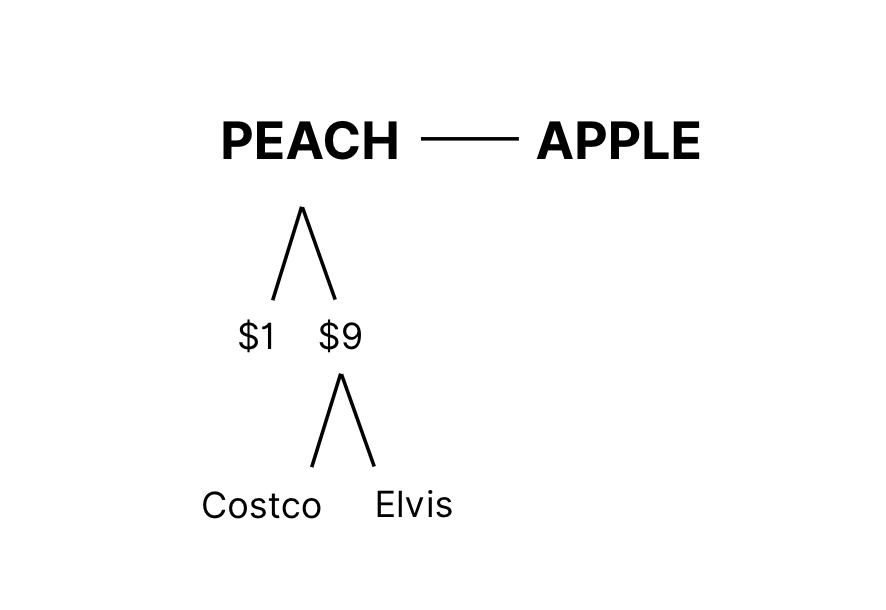There are eight identical peanut butter and jelly sandwiches.
All sitting on identical plates.
And you?
You have to choose one.
(It doesn’t matter if you hate peanut butter and jelly IRL. For the sake of this thought experiment? You and PB&J? You go together like…wellll…peanut butter and jelly.)
All the sandwiches are made on identical white bread.
And they’ve all been cut to an identical size.
The amount of peanut butter and jelly on each?
It’s been measured down to the gram.

Sooooo, with all of that identical-ness in mind…
Which sandwich do you choose?
You’re human (I assume?!?), which means you’re likely to rely on some arbitrary tiebreaker to decide.
You might draw on some deep well of superstition to say something like:
“Well, #2 was the number of my basketball jersey in high school, so….”
Or:
“This one is the closest to me, so I’ll go for that.”
If there’s someone else in the room with you, you might even defer the choice. Saying:
“Well, which one would YOU go for?”
As the paradox of choice (a concept popularized by psychologist Barry Schwartz) tells us, more choices don’t always lead to more freedom.
In fact, they often lead to heightened anxiety, sweaty feelings of regret, and the sense that no choice would have been preferable over…whatever the heck this sweaty-palm feeling of indecision is.
But!
Let’s imagine for a second that each of those PB&Js came with a price tag.
Some are $1. And some are $9.
And!
Some have peach jelly, while some have apple jelly.
And!
Of that peach jelly, some has been bought in bulk at Costco.
While one special sandwich is made with jelly made on a 100-year-old peach farm, using a recipe that Elvis Presley once called “better than a hound dog”…
Now which sandwich would you choose?

Well, the answer isn’t quite so simple.
Because if you absolutely hate peach jelly, then you might be eyeing the apple — even if Elvis would come back from his grave to haunt you for that choice.
And if you only have $1 in your pocket, then Elvis might be out — even if that sandwich is your peach dream.
And even if you have very little interest in paying $9 for a peach PB&J, you may be convinced to go that direction if:
- That sandwich comes with 300+ five-star reviews
- It’s been awarded a Michelin star (the highest of all food honors)
- Someone is in the room to convince you *that this sandwich* will impress the crap out of your in-laws at the dinner party you’re throwing for them later
At its most base level, this is how differentiation works in marketing.
One market category
Is made up of a variety of deceptively-similar things
All with an attached price
And a unique backstory (built by features, processes, you name it)
That makes it more/less appealing to an audience who wants/needs that thing
With clear copy that makes those appealing qualities known
Now, why is the PB&J example so helpful here?
Because it gives voice to the reality of what market differentiation is and how it functions.
It is not, as some believe, a way of stealing a massive amount of market share by finding some secret formula way of appealing more widely to more people.
It is, in fact, a narrowing.
Where you might say:
“We are peach jelly. If you don’t like peach jelly, we are not for you.”
Or:
“We are made from Elvis Presley’s favorite recipe. If you cannot afford us, then we are not for you.”

And while that might seem on the surface like a good way to get fewer customers instead of more, it cuts through two very psychological phenomena that can lead to sales stagnation:
- Choice overload: the phenomenon of overwhelm that comes from having too many choices
- Decision paralysis: the phenomenon of abandoning a choice because making one just feels too dang hard
Lack of differentiation is bad for all
“I’m more of a community over competition kind of person.”
That’s what a former client (a service provider for 6 and 7-figure brands) said, while staring down the strategic lay of the competitor landscape that I’d just dropped into their hands.
In layman’s terms:
They were more interested in being friends with their competitors than beating them.
Which meant they weren’t super excited about the prospect of strategically finding the gaps they could fill…OR about finding the right words to show how they were differentiated in a saturated market.
Which is fine! Which is great! Which is a wonderful worldview that I hope we all can get a bigger taste of!
Except…
A market full of people who talk, think, act, and show up the same makes things *harder* not easier — for all.
- When people have more choices, they buy less overall
- More choices = higher expectations, which often leads to greater dissatisfaction when those expectations are not met
When the number of choices got above a certain threshold (one that is quickly and easily met in the context of today’s overstuffed markets), consumers actively needed help managing the available choices.

One way you can do that as a brand?
You guessed it:
*Differentiate yourself*
By:
- Being clear about who you are or who you are not for (the peach vs. apple jelly distinction)
- Making comparison between you and others easy — by setting yourself apart in obvious ways
- Use branding and copy to strategically make those distinctions, comparisons, and differentiation points known in a compelling way (because it doesn’t matter if you *do a thing* if no one on the planet knows you do that thing!!!)
What’s the danger of *not differentiating* (aka: what do you lose?)
My client was a standout in their market.
They had a product. That people loved. That was made in unique-to-them ways.
But their sales had stalled, then started to dip.
Despite having a differentiated product with differentiated processes…
Their customers didn’t *know* that.
Which left them feeling like background noise in a market of products who *were* putting work into setting themselves apart.
To fix the whole our sales are going down every month and last year’s numbers are but a pipe dream thing, they were putting effort into two areas:
1). Price: offering more and more complicated discount programs, while keeping the product price fixed (despite rising expenses) in an attempt to under-bid other options and drum up more sales
2). Visibility: trying to shortcut the decision making process by being the one people saw more and more often through aggressive ad campaigns that cost oodles of moolah
Both worked to an extent.
(Because price *is* a driving force and more visibility *will* get you more sales opportunities.)
But only slightly.
And not enough to even begin cover the astronomical amount of profit they were losing to discounts or funneling into ad spend.
Enter:
Differentiation.

Which helped this 7-figure e-commerce company *effectively double* their revenue at 99% year-over-year growth. (See the case study for more on that.)
And that’s the thing…
When differentiation strategies aren’t at play, you’re forced to compete for audience attention using those two things:
Price and visibility
Which only works short-term.
And only so long as you’re willing to feed the ad spend beast.
And only so long as you can stomach underselling yourself to get the sale…even as your competitors continue to rake in profits at higher prices.
So….what even does differentiation look like?
When sock company Bombas showed up on Shark Tank with a “one bought, one donated” model, the sharks were like…

Despite starting skepticism, the Bombas website crashed the day that the Shark Tank episode went live…
…in just 30 seconds of the episode airing.
Why?
Well, they had good socks.
Even really good socks.
But so did plenty of other brands.
And now they had visibility.
But so did plenty of other brands, and their sites don’t crash in less than a minute.
What they had?
Was a differentiation story.
United under a “one bought, one donated” mission.
That made them stand out in a market full of people doing *very* similar things.
And made them easy to choose above plenty of others.
(Bombas is now rocking around $500 million in revenue, just in car you’re interested in putting a hard number to their success.)
So where does that leave you?
Maybe you’re reading this thinking: “Okay!! I get it!!! Differentiation matters!!!! But I have no idea what makes us different…”
Or maybe you *know* what makes you different, but you don’t know how to communicate it in a way that actually resonates to the tune of year-over-year growth.
Or maybe you’re working hard to communicate it, but don’t know where you’re falling short of turning that into real revenue. (Is our messaging the problem? Or is it something else entirely?)
Truth is: you likely already have differentiation points. They’re just buried, unclear, or not making it into the places where customers are making decisions.
The work isn’t inventing something from scratch. It’s uncovering what’s already true about your brand and banking on real buyer psychology to drive real conversions.
To tell your own differentiation story as an e-commerce brand, digital creator or consultant (to the tune of more sales)? Start here: with a free 14-minute strategy chat.